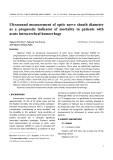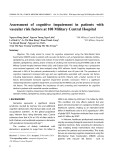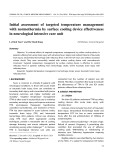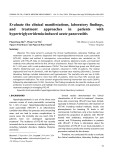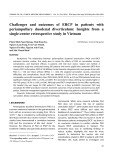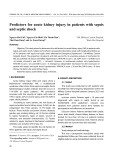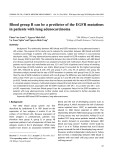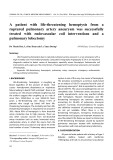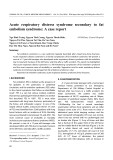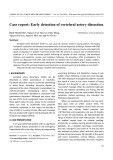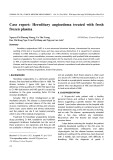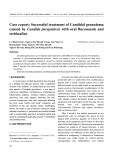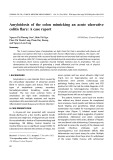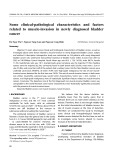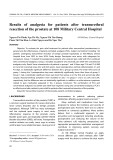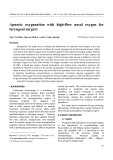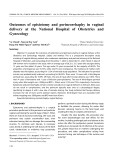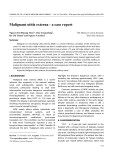
HUE JOURNAL OF MEDICINE AND PHARMACY ISSN 3030-4318; eISSN: 3030-4326HUE JOURNAL OF MEDICINE AND PHARMACY ISSN 3030-4318; eISSN: 3030-4326
84 85
Hue Journal of Medicine and Pharmacy, Volume 15, No.2/2025 Hue Journal of Medicine and Pharmacy, Volume 15, No.2/2025
Prevalence and risk factors of low bone mineral density in
spondyloarthritis
Nguyen Hoang Thanh Van*, Pham Thi Thuy Dung
Department of Internal Medicine - University of Medicine and Pharmacy, Hue University
Abstract
Background: Osteopenia is a common bone disorder that is the most prevalent underlying cause of
fractures. One of the causes of secondary osteopenia is spondyloarthritis. The rate of bone loss in patients
with spondyloarthritis is relatively high in the early stages of the disease. Objectives: This study is evaluated
the prevalence and risk factors of low bone mineral density by Dual Energy X-ray Absorptiometry (DEXA)
in spondyloarthritis. Material and Methods: A cross-sectional description combined to retrospective with
control group. The spondyloarthritis group included 40 patients at the Department of General Internal
Medicine-Endocrinology-Rheumatology, Hue University of Medicine and Pharmacy Hospital. The group of
patients with 40 healthy people had their bone mineral density measured at the Department of Functional
Exploration - Hue University of Medicine and Pharmacy Hospital. Results: Spondyloarthritis is common in
men, accounting for 67.5%, with onset in young patients. In spondyloarthritis patients, the average bone
mineral density in the lumbar spine was 0.908 ± 0.193 g/cm², at the femoral neck was 0.910 ± 0.208 g/cm²,
at the total hip was 0.910 ± 0.208 g/cm², much lower than the control group with statistical significance
(p<0.05). The rate of osteopenia in the lumbar spine is 22.5%, in the femoral neck and the total hip is 5%.
When comparing the mean bone mineral density of the spondyloarthritis group with the control group, in
the lumbar spine, the average bone mineral density of lumbar vertebrae L4 decreased the most by 12.7%.
Bone mineral density in the lumbar spine positively correlates with age, age of disease onset, disease
duration, and BMI (body mass index), with no correlation with CRP value, erythrocyte sedimentation rate,
disease activity level, lesions sacroiliac joint injury on X-ray. Bone mineral density at the femoral neck
was not associated with sex, age, age of onset, disease duration, BMI, CRP, erythrocyte sedimentation rate,
disease activity level, sacroiliac joint damage on X-ray, and treatment. Conclusions: Osteopenia is common in
patients with spondyloarthritis, especially in the lumbar spine. Bone mineral density in the lumbar spine was
positively correlated with age, age of disease onset, disease duration, and BMI.
Keywords: spondyloarthritis, osteoporosis, bone mineral density, osteopenia, Vietnam.
*Corresponding Author: Nguyen Hoang Thanh Van
Email: nhtvan@huemed-univ.edu.vn; nhtvan@hueuni.edu.vn
Received: 12/1/2025; Accepted: 10/3/2025; Published: 28/4/2025
DOI: 10.34071/jmp.2025.2.13
1. INTRODUCTION
Osteoporosis is a bone disorder characterized
by decreased bone strength that increases the
fracture risk. Bone strength is reflected by bone
density and bone quality. Osteoporosis is the
most common underlying cause of fractures and
accounts for approximately 1.5 million fractures in
the United States each year. In addition, each year,
there are more than 500,000 hospitalizations, more
than 2.6 million medical visits, more than 800,000
emergency hospital admissions, and approximately
180,000 people enrolled in nursing homes in the
US. It is predicted that by 2040, the cost of treating
osteoporosis and its complications will increase from
100% to 200% [1].
Based on the cause, osteoporosis is divided
into two main groups: primary and secondary
osteoporosis [2]. One of the causes of secondary
osteoporosis is spondyloarthritis. Decreased bone
mineral density and osteoporotic vertebral fractures
are known complications of spondylitis, especially in
ankylosing spondylitis. A reduction in bone density
has been reported as high as 47% in the lumbar
and femoral spine, even in patients with early-
stage spondyloarthritis [3]. Patients with ankylosing
spondylitis may be at increased risk of bone loss due
to high levels of disease activity, proinflammatory
cytokines, mechanical factors (i.e., spinal stiffness,
vertebral deformity), and reduced physical activity or
mineralization defects associated with inflammatory
bowel conditions [4].
Therefore, it is essential to evaluate the risk
factors for reduced bone density and osteoporosis
and predict the risk of fracture in patients with
spondyloarthritis, from which there are treatment
and preventive measures to reduce the risk of fracture





